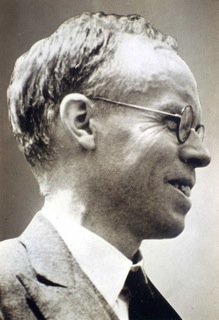
Caption: E.A. Milne (1896--1950) (see also E.A. Milne (1896--1950): Biography) was an important 20th century cosmologist.
E.A. Milne originated the term cosmological principle in 1935 (Cormac O'Raifeartaigh, et al., 2017, p. 29) though the concept goes back to Isaac Newton (1643--1727) in Principia (1687) and maybe earlier (Wikipedia: Cosmological principle: Origin). It is one of the most basic assumptions of modern cosmology. Albert Einstein (1879--1955) used the cosmological principle (as a vastly simplifying assumption without using the term) in formulating early general relativistic cosmology and in his Einstein universe (presented 1917).
Of course, E.A. Milne (1896--1950) and other early users of the cosmological principle did NOT have extensive modern evidence for it. For them, it was a vastly simplifying assumption for research in cosmology that was consistent with the evidence they had.
- The photograph
shown here of E.A. Milne
was taken in
1939
by famous astronomer
Subrahmanyan Chandrasekhar (1910--1995).
- Milne
in 1935
was the proposer of what is now called the
Milne universe (AKA empty universe).
In the Milne universe the
cosmic scale factor
increases linearly with cosmic time:
i.e., a(t) = constant*t, where t is
cosmic time
(see
Wikipedia: Milne model: Milne metric).
So there is NO
acceleration NOR
deceleration
of the
expansion of the universe.
- The E.A. Milne Centre for Astrophysics
at the
University of Hull
(in Kingston upon Hull (usually called just Hull),
East Riding of Yorkshire,
England)
was named in E.A. Milne's honor.
He was born in Hull.
- E.A. Milne
would NOT have known poet
Philip Larkin (1922--1985), who
worked
1955--1985
at the University of Hull.
But Philip Larkin was a
friend of
astronomer
Alex Dalgarno (1928--2015) whom
yours truly occasionaly used to see at
Harvard-Smithsonian
Center for Astrophysics (CfA)
in 1991--1993.
So yours truly has
2 degrees of separation
to Philip Larkin and, since
Alex Dalgarno certainly had
contacts with Chandrasekhar,
3 degrees of separation
to E.A. Milne.
- E.A. Milne is NOT
a relation of A.A. Milne (1882--1956), but one
has to believe that he was amused by the similarity of their professional names.
- For a detailed explication of the
cosmological principle,
see Cosmology file:
cosmological_principle.html.
Image link: Edward Arthur Milne (1896-1950): Mathematician, Astrophysicist, Cosmologist.
Local file: local link: e_a_milne.html.
File: Astronomer file: e_a_milne.html.